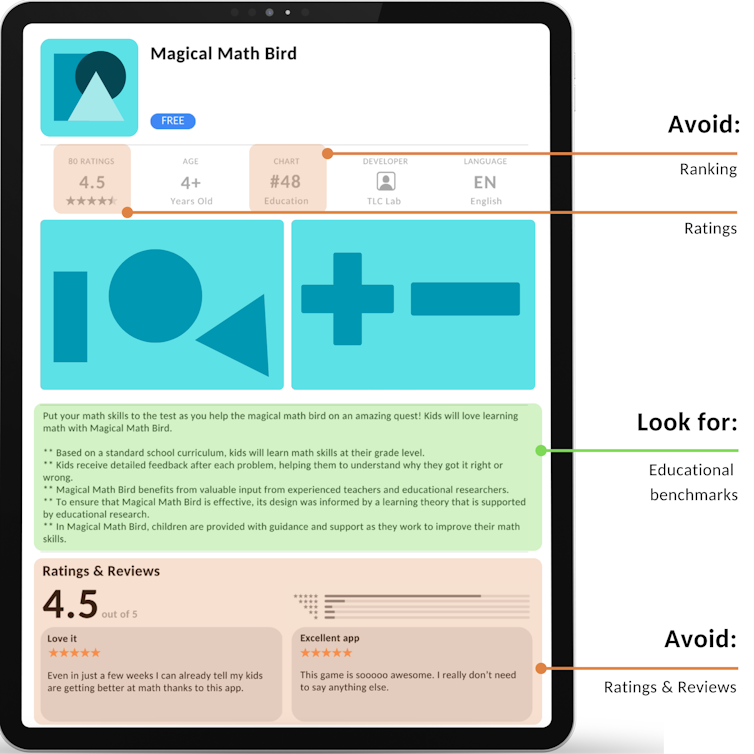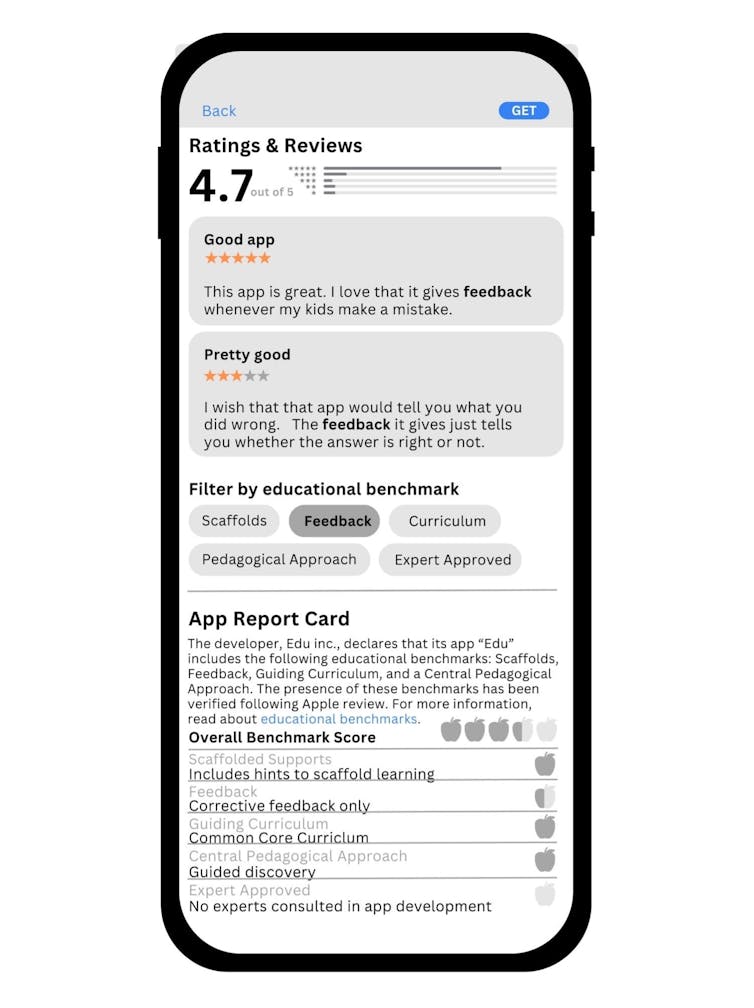Teachers and parents buy educational applications (EduApps) to help children learn, bringing billions of dollars to mobile software companies, a large part of which goes into the pockets of high-end software.
But when people visit software stores, they are overwhelmed with choices. Children can learn from well-designed EduApps, but choosing bad apps costs time and money for schools and families.
When choosing EduApps, our research from the Technology Learning and Cognition lab at McGill University’s Faculty of Education shows that teachers and parents rely heavily on the judgment of others, such as star ratings.
But software stores are not designed to reflect what consumers need to judge the software’s curriculum. For example, Apple says it has “the most well-curated App Store where every app is reviewed by experts and a team of editors helps users find new apps every day,” but the guidelines don’t include educational content.
Worth ignoring
We advise teachers and parents to ignore non-curricular content, such as:
1. User ratings and reviews:
Popular EduApps in the Apple and Google stores have excellent ratings (above four stars).
However, experts still complain about their quality and programs that are approved by experts do not receive the highest stars.
Written comments are less informative. Research shows that most of the reviews are just praising the software rather than explaining the specifics.
Even if the review mentions studies, few reviewers have the basis to make clear conclusions. Anyone can review an app – even kids, who love apps that allow them to have fun while learning but don’t know what it takes to learn well.
2. Apple or Google rankings
Teachers and parents can go to the “top charts” in the app store to find EduApps. However, how Apple and Google’s algorithms determine which apps are “top of the charts” is unclear.
Additionally, the rankings are not related to academic excellence, making them unreliable in selecting top programs.
3. Tips from program review sites
Educators and parents can look to external app review websites like Common Sense Media for recommendations. But research shows that many of the apps recommended by these sites still need significant improvements — and only a handful of apps are being evaluated. Avoid relying on recommendations from this website.

(Emma Liptrot/Adam Kenneth Dube)
Worth checking out
We want to look at five educational benchmarks that can be found in the written text of the program, where the developers describe the program and its features.
1. Education: What programs do they teach
At a minimum, EduApps should integrate the content of the standard learning program. However, many EduApps are what researchers call “educational misfits” because they are only related to education, if at all. Look for programs that clearly state where the curriculum is based (for example, regional studies, extracurriculars to learn the local language) or details about the content (eligible for math 1-3). Don’t worry about a program that doesn’t tell you what it covers.
2. Concept of learning: How programs teach
The founders’ idea of learning – their theory – affects the activities that children are asked to do and what kind of learning can take place. A program that uses repetition to help children memorize information promotes different learning outcomes and meets different needs than a program that encourages experimentation and discovery. Look for programs that describe how they teach. Choose the ones using the methods that suit your needs.
If a program doesn’t tell you how it helps children learn, it’s not worth your time.
3. Scaffolding: How software supports learning
EduApps should have resources that help children understand and achieve educational goals. These aids (called scaffolding) may include instructions or guidance when children are struggling and breaking complex tasks into smaller parts or modifying challenges to match children’s abilities. Look for programs that have resources that help guide and improve children’s education.
4. Review: How software improves learning
If we want children to learn from their mistakes, accountability is essential. Look for programs that give kids lots of feedback so they know when they made a mistake and why.
5. Academician: Who created the program
Most programmers are not academics, and their priorities may not align with those of teachers and parents. Look for programs that partner with academics such as teachers or researchers to be designed with children’s needs and abilities in mind.
Some facts
Our five academic standards focus on academic potential. However, other considerations related to child safety are also important, such as how apps manage children’s privacy and data and how children view advertising.
Read more: Why freemium software has no place in our classrooms
Working together to select the best programs
How the current app store helps finding the perfect EduApp is like searching for a drop in the ocean. To help them search, teachers and parents can look for educational indicators, and watch our video on YouTube, “How to find an educational program.”
We conducted research to show that this helped parents identify the best educational programs using the benchmarks discussed above.
Finding a good EduApp shouldn’t be too difficult. These for-profit software vendors are responsible for ensuring that families’ and schools’ finances are not wasted on malicious software. We’re calling on Apple and Google to redesign their app stores to display educational symbols.

(Liptrot and colleagues)
Such revisions can make it easier to find good programs in the sea of possibilities.
With so many apps available, store owners, researchers, teachers and parents need to work together to get the best EduApps into the hands of kids.
#Educational #programs #children #parents #teachers #ignore